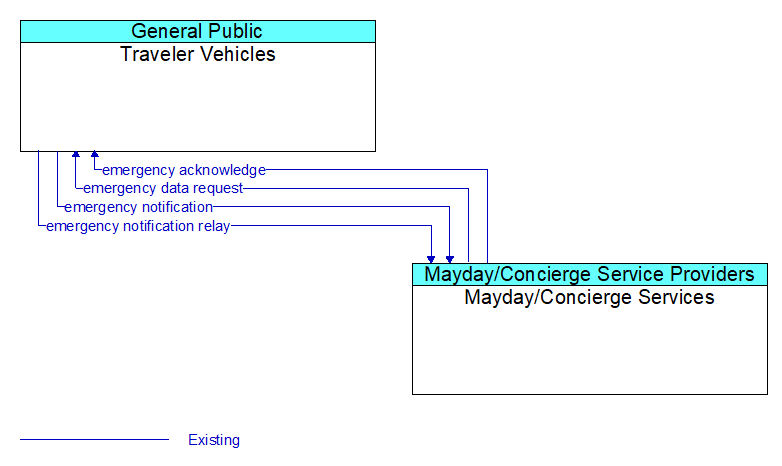Interface: Traveler Vehicles - Mayday/Concierge Services

Architecture Flow Definitions
emergency acknowledge (Existing) Applicable ITS Standards
Acknowledge request for emergency assistance and provide additional details regarding actions and verification requirements.
emergency data request (Existing) Applicable ITS Standards
A request for additional information or a control command issued by the emergency response agency in response to an emergency request for assistance from a traveler.
emergency notification (Existing) Applicable ITS Standards
An emergency request for assistance that is automatically initiated by a vehicle or manually initiated by a vehicle occupant. The request includes call–back number, date, time, location, pre–event vehicle heading, vehicle make, model, model year, and fuel type, and crash severity indicators. Crash severity indicators include: airbags deployed, number of impacts, crash delta velocity, principle direction of force, and rollover indication. In addition, seatbelt restraint use, number of occupants, occupant location, and intrusion may be included. For commercial vehicles, this flow may also include freight equipment type (box, flatbed, trailer, container, etc.), type of cargo (refrigerated, non–perishable, liquid, etc.), hazardous material data, quantity of cargo, and cargo permits as applicable (hazmat, special routing permissions).
emergency notification relay (Existing) Applicable ITS Standards
The relay of a previously received emergency notification. This relay enables a connected vehicle that is passing within radio range of a vehicle in need of assistance to store the notification and then forward it to a public safety agency when communications is available. Multiple relays may be necessary in remote areas with infrequent traffic and spotty communications coverage. The relay includes all of the information included in the original emergency notification (see 'emergency notification') and relay–specific data that can be used to manage the relay. Relay–specific data may include the date and time of original emergency notification receipt and the number of times the message has been relayed.